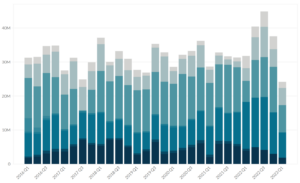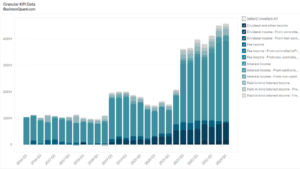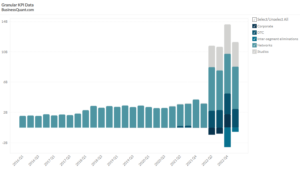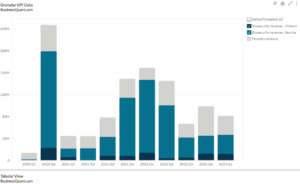
Texas Instruments’ Revenue by Segment (2016-2023)
Exclusive Data
You need the Pro Plan to access KPI data
- Full access to the platform
- KPI data & segment financials on US stocks
- Financial data on thousands of stocks
- Download data in xlsx and csv formats
Pro Plan
$49 per month*
60% discount ends in:
.
About
More information
Subscribe to Pro or Enterprise plans to unlock this feature.
Contact the Analyst
Subscribe to Pro or Enterprise plans to unlock this feature.
Become a smarter investor today.
Access KPIs & Segment Financials on US stocks
This Statistic shows Texas Instruments’ Revenue by Segment from 2016 onwards, split across Analog and Embedded Processing segments.
Texas Instruments is a semiconductor company that designs, develops, and sells semiconductors to electronics designers and manufacturers around the world. They manufacture and sell their products, in more than 30 countries.
Texas Instruments’ Revenue by Segment
Texas Instruments segments are sets of related goods that have been grouped based on product development needs, attributes, and manufacturing processes. They are:
- Analog
- Embedded Processing
- Others
| Segment | Revenue in Q1 2020 | Revenue in Q4 2020 | Revenue in Q1 2021 | Revenue Share in Q1 2021 |
| Analog | $2460 | $3127 | $3280 | 76% |
| Embedded Processing | $653 | $720 | $767 | 18% |
| Other | $216 | $229 | $242 | 6% |
| Total | $3329 | $4076 | $4289 | 100% |
(All figures in millions, except percentages)
In Q1 2021, Texas Instruments’ total revenue amounted to $4289 million, marking a 29% year-on-year growth from $3329 million in Q1 2020. This was also a 5% increase compared to $4076 million generated in Q4 2020.
Texas Instruments’ revenue is further bifurcated as per the following segments:
Analog
The major product lines of Texas Instruments’ Analog segment include Power and Signal Chain. Power involves items that help clients control power in electronic systems, in all markets. Products in the Signal Chain sense, condition, and measure real-world signals to transport or convert data for further processing and control.
The majority of Texas Instruments’ revenue is generated through the Analog segment, which contributed 76% of the total revenue, amounting to $3280 million during Q1 2021. This indicates a growth of 33% compared to a year ago when the revenue generated was $2460 million and a 5% growth compared to Q4 2020 when the revenue was $3127 million. As the digitization of electronics advances, analog chips will constantly be required to power devices and offer vital interfaces with humans, the real world, and other electronic devices.
Embedded Processing
The Embedded Processing segment includes microcontrollers, digital signal processors (DSPs) and applications processors. Microcontrollers are self-contained devices that have a CPU core, memory, and peripherals and are used to operate a set of particular functions in electronic equipment. DSPs perform mathematical computations almost instantly. Applications processors are dedicated to a single type of computing task. Depending on the application, Embedded Processing products are designed to accomplish specific jobs and can be optimized for various combinations of performance, power, and cost.
Texas Instruments’ revenue from the Embedded Processing segment increased from $653 million in Q1 2020 to $767 million in Q1 2021, marking a 17% increase on a year-on-year basis. It also increased by 7% from $720 million in Q4 2020, on a quarter-to-quarterly basis. This segment accounted for 18% of the total revenue during Q1 2021.
Other
The Other segment consists of items that aren’t used in evaluating the results of the segments or assigning resources to them. Acquisition charges, restructuring charges, and certain corporate-level items, such as litigation expenses, environmental expenditures, and gains and losses from other activities, such as asset dispositions, are examples of these items.
Texas Instruments’ revenue from the Other segment stood at $242 million during Q1 2021, which was a 12% increase compared to Q1 2020 where it was $216 million and a 6% increase compared to $229 million generated in Q4 2020. This segment accounted for a small share of 6% of the total revenue during Q1 2021.
About Texas Instruments
Texas Instruments Inc. is an American technology firm. It is headquartered in Dallas, Texas. After a reorganization of Geophysical Service Incorporated, a company founded in 1930 that made seismic equipment as well as defence electronics, Texas Instruments was formed in 1951.
In 1954, TI developed and manufactured the world’s first commercial silicon transistor, as well as the first transistor radio. While working at TI’s Central Research Labs in 1958, Jack Kilby designed the integrated circuit. In 1967, TI also pioneered the hand-held calculator. The digital light processing device (also known as the DLP chip) was designed by Texas Instruments in 1987, and it serves as the foundation for the company’s award-winning DLP technology and DLP Cinema. In 1990, TI developed the iconic TI-81 graphing calculator, which quickly became a market leader in the graphing calculator business. They acquired National Semiconductors in 2011.
Texas Instruments’ portfolio consists of more than 45000 products including calculators, microcontrollers, and multi-core processors. Major competitors of the company are NXP Semiconductors, Qualcomm, Infineon Technologies, and Maxim Integrated. In the Analog semiconductor industry, Texas Instruments has the biggest market share.
Did you like Texas Instruments’ Revenue by Segment statistic?
Access thousands of more such key performance indicator data points, on listed companies, with Business Quant.
You can also get started for free.
More data on US Stocks

Our Plans
Always know what you’ll pay. No hidden costs or surprises.
- Annual
- Monthly
60% discount till this Sunday
Pro
For serious investing
-
Company KPI data Access segment financials, non-GAAP metrics and KPI data from presentations and filings. Examples include financials by segment / region / product category, AT&T's broadband subscriber trends, Tesla's deliveries by model and lots more.
-
Stock research tools Features include : stock screener, stock comparison, industry financials, stock warnings, advanced charting tools, timeseries tables, scatter charts, financial statements, stock reports, SEC filings, stock ratings, institutional and insider ownership data. There are 200+ financial items and ratios on thousands of US stocks.
-
Industry data & tools Access premium operating data on 40+ industries. Examples include market share, smartphone shipments by vendor, subscribers by wireless carrier, historical gold production. There are 20,000+ such statistics.
Enterprise
For tailored workflows
-
All of Pro plan Get unfettered access to all our dashboards and dossiers.
-
Custom built features Get tailored dashboards built specially for you , based on your set of requirements, to simplify your research workflow.
-
Admin billing Back-end documentation support and multi-seat licensing.
* Billed annually, local taxes extra.
60% discount on Annual plan
Pro
For serious investing
-
Company KPI data Access segment financials, non-GAAP metrics and KPI data from presentations and filings. Examples include financials by segment / region / product category, AT&T's broadband subscriber trends, Tesla's deliveries by model and lots more.
-
Stock research tools Features include : stock screener, stock comparison, industry financials, stock warnings, advanced charting tools, timeseries tables, scatter charts, financial statements, stock reports, SEC filings, stock ratings, institutional and insider ownership data. There are 200+ financial items and ratios on thousands of US stocks.
-
Industry data & tools Access premium operating data on 40+ industries. Examples include market share, smartphone shipments by vendor, subscribers by wireless carrier, historical gold production. There are 20,000+ such statistics.
Enterprise
For tailored workflows
-
All of Pro plan Get unfettered access to all our features.
-
Custom built features Get tailored dashboards built specially for you , based on your set of requirements, to simplify your research workflow.
-
Admin billing Back-end documentation support and multi-seat licensing.
* Local taxes extra.






